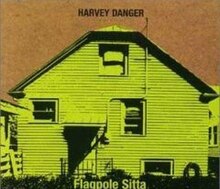Flagpole Sitta
| "Flagpole Sitta" | ||||
|---|---|---|---|---|
 | ||||
| Single by Harvey Danger | ||||
| from the album Where Have All the Merrymakers Gone? | ||||
| B-side | "The Ballad of the Tragic Hero (Pity and Fear)" | |||
| Released | July 1997[1] | |||
| Recorded | June 1996 | |||
| Genre | ||||
| Length | 3:37 | |||
| Label | Slash | |||
| Songwriter(s) | Sean Nelson, Jeff J. Lin, Aaron Huffman, Evan Sult | |||
| Producer(s) | John Goodmanson, Harvey Danger | |||
| Harvey Danger singles chronology | ||||
| ||||
| Audio sample | ||||
"Flagpole Sitta" | ||||
"Flagpole Sitta" is a song by American rock band Harvey Danger from their 1997 debut album, Where Have All the Merrymakers Gone?.
Composition
The song was recorded during the 1996 sessions for Where Have All the Merrymakers Gone? According to drummer Evan Sult, the song was written as a response to the Seattle music scene of the 1990s and its effect on mainstream culture.[2]
The title of the song was inspired by the 1930 Marx Brothers film Animal Crackers, which features a line of dialogue about the pole sitting fad of the 1920s.[3] The band was inspired to spell "sitter" as "sitta" by the Pavement song "Fame Throwa" and the N.W.A album Straight Outta Compton.[3]
Release
It was released as a single in July 1997. The song gained popularity after Sean Nelson gave a copy of the album to a KNDD DJ. Shortly after this, it was picked up by KROQ-FM. It then appeared at number 38 on the Billboard Hot 100 Airplay chart. A music video was produced to promote the single.[4] The song is regarded as a power pop single by MTV and a post-grunge anthem by author Ericka Chickowski.[5][6] PopMatters describes the single as "a hyper-literate alt-rock dissection of the stupidity of the modern age".[7] Music journalist Rob Sheffield also considers the song as "nineties pop-punk rage at its loudest".[8]
Track listing
| No. | Title | Length |
|---|---|---|
| 1. | "Flagpole Sitta" | 3:37 |
| 2. | "Wrecking Ball" | 4:39 |
| 3. | "The Ballad of the Tragic hero (Pity and Fear)" | 4:30 |
| No. | Title | Length |
|---|---|---|
| 1. | "Flagpole Sitta" | 3:37 |
| 2. | "The Ballad of the Tragic hero (Pity and Fear)" | 4:30 |
Charts
| Chart (1997–1999) | Peak position |
|---|---|
| Australia (ARIA)[9] | 50 |
| Canada Rock/Alternative (RPM)[10] | 9 |
| France (SNEP)[11] | 98 |
| Iceland (Íslenski Listinn Topp 40)[12] | 14 |
| Scotland (OCC)[13] | 63 |
| UK Singles (OCC)[14] | 57 |
| US Radio Songs (Billboard)[15] | 38 |
| US Adult Pop Airplay (Billboard)[16] | 31 |
| US Alternative Airplay (Billboard)[17] | 3 |
| US Mainstream Rock (Billboard)[18] | 33 |
| US Pop Airplay (Billboard)[19] | 32 |
Legacy
"Flagpole Sitta" was used as the theme song for the British sitcom Peep Show for the second series onwards. In 2008, Harvey Danger singer Sean Nelson stated that Peep Show is "...the only pop culture item the song has been associated with that feels like a kindred spirit to the original attitude of the lyric."[20] In 2016, he said: "It’s a joy to be affiliated with something that’s so smart and so funny and so kind of rude and weird."[2] Rolling Stone ranked the song the 25th best of the 1990s.[21]
References
- ^ http://www.stereogum.com/1954631/flagpole-sitta-at-20-a-conversation-with-harvey-dangers-sean-nelson/franchises/tracking-down/
- ^ a b Zaleski, Annie. "Why Harvey Danger's '90's Alt-rock Hit "Flagpole Sitta" endures". The A.V. Club. Retrieved November 11, 2015.
- ^ a b Weiss, Dan (July 28, 2017). ""Flagpole Sitta" At 20: A Conversation With Harvey Danger's Sean Nelson". Stereogum. Retrieved July 31, 2017.
- ^ Harvey Danger - Flagpole Sitta (Official Music Video). YouTube. March 25, 2011.
- ^ Devenish, Colin (May 12, 1998). "Harvey Danger's 'Flagpole Sitta' Sitting Pretty On Rock Radio". MTV News. Retrieved September 12, 2015.
- ^ Ericka Chickowski (July 3, 2012). Moon Washington. Avalon Travel Publishing. p. 147. ISBN 978-1-61238-261-6.
- ^ Sawdey, Evan (June 5, 2013). "Harvey Danger's Unsung Masterpiece". PopMatters. Retrieved September 12, 2015.
- ^ Sheffield, Rob (July 31, 2013). "Rob Sheffield's 10 Perfect Karaoke Jams". Time. Retrieved September 12, 2015.
- ^ "Harvey Danger – Flagpole Sitta". ARIA Top 50 Singles.
- ^ "Top RPM Rock/Alternative Tracks: Issue 3620." RPM. Library and Archives Canada. Retrieved March 5, 2019.
- ^ "Harvey Danger – Flagpole Sitta" (in French). Les classement single.
- ^ "Íslenski Listinn Topp 40 (1.10–8.10. 1998)". Dagblaðið Vísir (in Icelandic). October 2, 1998. Retrieved October 4, 2019.
- ^ "Official Scottish Singles Sales Chart Top 100". Official Charts Company. Retrieved March 5, 2019.
- ^ "Official Singles Chart Top 100". Official Charts Company. Retrieved March 5, 2019.
- ^ "Harvey Danger Chart History (Radio Songs)". Billboard. Retrieved October 4, 2019.
- ^ "Harvey Danger Chart History (Adult Pop Songs)". Billboard. Retrieved October 4, 2019.
- ^ "Harvey Danger Chart History (Alternative Airplay)". Billboard. Retrieved October 4, 2019.
- ^ "Harvey Danger Chart History (Mainstream Rock)". Billboard. Retrieved October 4, 2019.
- ^ "Harvey Danger Chart History (Pop Songs)". Billboard. Retrieved October 4, 2019.
- ^ "Harvey Danger interview". June 21, 2008. Retrieved January 8, 2009.
{{cite journal}}: Cite journal requires|journal=(help) - ^ Sheffield, Rob. "The 50 Best Songs of the Nineties". Rolling Stone. Retrieved March 12, 2017.
External links
- "Single Again: Harvey Danger – 'Flagpole Sitta' « Radio.com". radio.com.
- "Relive Your Wasted Youth: Here's What You Don't Know About 'Flagpole Sitta'". MTV News.
- "Flagpole Sitta". Rolling Stone.
